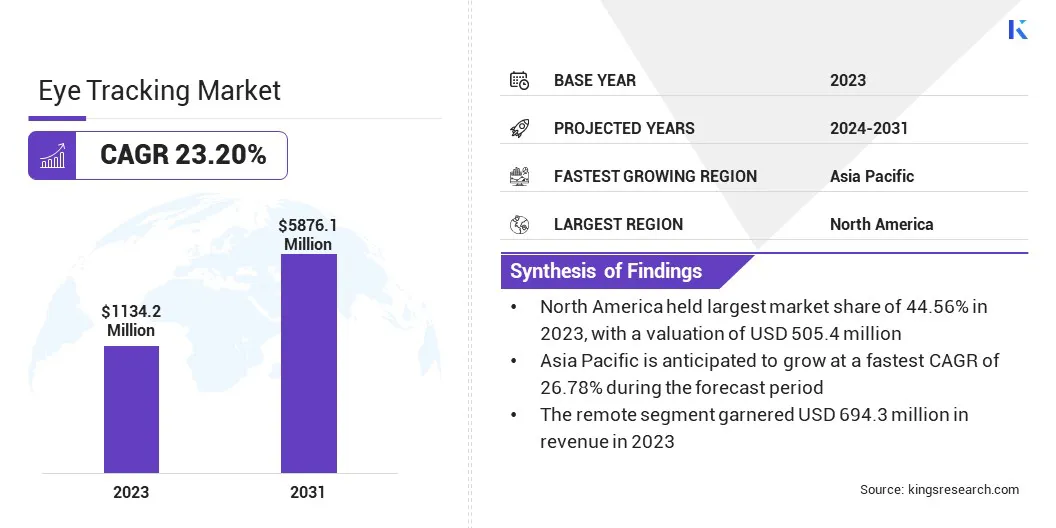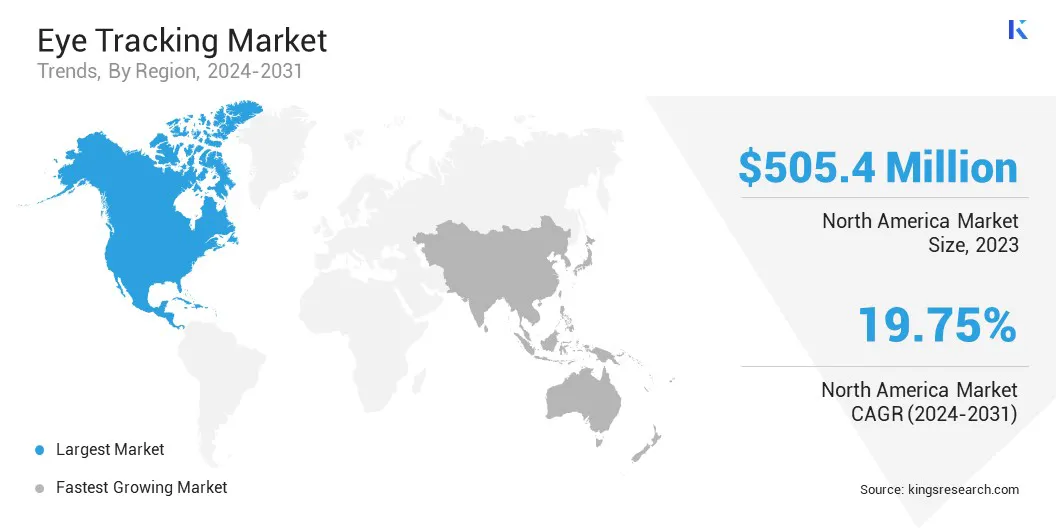Market Definition
The market develops and deploys technology for monitoring and analyzing eye movement, gaze patterns, and visual attention. This market serves industries such as healthcare, automotive, retail, research, and gaming, allowing for better user experiences, deeper data insights, and optimum performance in a variety of applications.
Eye Tracking Market Overview
The global eye tracking market size was valued at USD 1,134.2 million in 2023, and is projected to grow from USD 1,364.0 million in 2024 to USD 5,876.1 million by 2031, growing at a CAGR of 23.20% during the forecast period.
The market is driven by the increasing demand for advanced research tools, rising adoption in healthcare & automotive industries, technological advancements in eye tracking devices, and the expanding use of eye tracking in advertising, UX testing, and virtual reality applications.
Major companies operating in the global eye tracking market are Tobii, SR Research Ltd., EyeTracking, Smart Eye Aktiebolag (publ)., iMotions, gazepoint, Eyegaze Inc., Seeing Machines., EyeTech Digital Systems, Inc., The EyeTribe, Pupil Labs GmbH., GazeRecorder, RealEye sp. z o. o., Lumen Research Ltd., and Ergoneers GmbH.
Regulatory frameworks for healthcare and automotive applications are promoting the integration of eye tracking for medical diagnostics and driver assistance systems. Companies are investing in product innovations and strategic partnerships to enhance their market presence and capitalize on the growing demand for eye tracking solutions globally.

Key Highlights:
- The eye tracking industry size was valued at USD 1,134.2 million in 2023.
- The market is projected to grow at a CAGR of 23.20% from 2024 to 2031.
- North America held a market share of 44.56% in 2023, with a valuation of USD 505.4 million.
- The healthcare segment garnered USD 278.0 million in revenue in 2023.
- The optical tracking segment is expected to reach USD 2,779.1 million by 2031.
- The hardware segment garnered USD 668.3 million in revenue in 2023.
- The remote segment is expected to reach USD 3,199.5 million by 2031.
- The market in Asia Pacific is anticipated to grow at a CAGR of 26.78% during the forecast period.
Market Driver
"Advancements in AI, UX Testing, and Personalized Consumer Insights"
The eye tracking market is expanding constantly, driven by the rising demand for advanced data analytics in different industries, including healthcare, automotive, and market research. The growing usage of eye tracking in UX testing, advertising, and virtual reality is accelerating its adoption.
Furthermore, advances in Artificial Intelligence (AI) and Machine Learning (ML) improve the accuracy and efficiency of eye tracking systems, making them more affordable and scalable. The increased emphasis on individualized consumer experiences and improved product design contributes to the market growth.
In addition, the increasing focus on individualized customer experiences, combined with an increased interest in enhancing product designs based on real-time consumer input, is fueling the market expansion.
- In November 2024, Smart Eye launched Smart Eye Pro 13, an upgraded eye tracking solution with automatic profile selection and improved user recognition. These features enhance tracking accuracy and streamline data integrity across multiple sessions, optimizing the eye tracking experience.
Market Challenge
"High Implementation Costs"
High implementation costs pose a significant challenge to the eye tracking industry, particularly for high-precision systems crucial for research and healthcare applications. These high costs can hinder wider adoption, limiting access to this technology for many potential users and organizations.
Companies can pursue several strategies to address high implementation costs in the market. These include investing in Research and Development (R&D) for more affordable components and streamlined software, offering tiered pricing and modular systems, exploring leasing options, and leveraging partnerships to share development costs.
Supporting industry standards and open-source platforms can also drive down overall market prices.
Market Trend
"Rising Demand, AI Advancements, and Growing Personalization"
The eye tracking market is registering several key trends, including the increasing incorporation of eye tracking into consumer-focused applications, such as retail and personalized marketing. The use of eye tracking in automotive driver assistance systems is growing, providing valuable insights for safety and user interface improvements.
Additionally, advancements in wearable and mobile eye tracking devices are making the technology more accessible to diverse industries. The rise of virtual and augmented reality (VR/AR) applications is also driving the demand for eye tracking to enhance immersive experiences. Lastly, AI-powered analytics are being integrated with eye tracking systems for more predictive and actionable insights.
- In May 2024, Apple Inc. announced eye tracking for iPad and iPhone, empowering users with physical disabilities to navigate devices using only their eyes. Powered by AI, the feature ensures quick setup, secure on-device data processing, and eliminates the need for additional hardware, enhancing accessibility across iPadOS and iOS apps.
Eye Tracking Market Report Snapshot
| Segmentation |
Details |
| By Application |
Healthcare, Retail, Research, Automotive, Automotive, Consumer Electronics, Others |
| By Technique type |
Eye Attached Tracking, Optical Tracking, Electro Oculography |
| By Component |
Hardware, Software |
| By Location |
Remote, Mobile |
| By Region |
North America: U.S., Canada, Mexico |
| Europe: France, UK, Spain, Germany, Italy, Russia, Rest of Europe |
| Asia Pacific: China, Japan, India, Australia, ASEAN, South Korea, Rest of Asia Pacific |
| Middle East & Africa: Turkey, UAE, Saudi Arabia, South Africa, Rest of Middle East & Africa |
| South America: Brazil, Argentina, Rest of South America |
Market Segmentation:
- By Application (Healthcare, Retail, Research, Automotive, and Consumer Electronics, Others): The healthcare segment earned USD 278.0 million in 2023, due to the growing use of eye tracking for patient monitoring, rehabilitation, and diagnostic tools, driving its significant contribution to the market.
- By Technique type (Eye Attached Tracking, Optical Tracking, Electro Oculography): The optical tracking segment held 50.52% share of the market in 2023, due to its widespread adoption in research, automotive, and consumer applications due to its accuracy, non-invasiveness, and ease of use.
- By Component (Hardware, Software): The hardware segment is projected to reach USD 3,074.5 million by 2031, owing to the increasing demand for advanced eye tracking devices and the expansion of wearable technologies for diverse industries, including automotive and healthcare.
- By Location (Remote, Mobile): The remote segment held 61.21% share of the market in 2023, due to its widespread usage in research, consumer behavior analysis, and healthcare, where fixed, high-precision systems are crucial for data accuracy and reliability.
Eye Tracking Market Regional Analysis
Based on region, the market has been classified into North America, Europe, Asia Pacific, Middle East & Africa, and Latin America.

North America accounted for around 44.56% share of the eye tracking market in 2023, with a valuation of USD 505.4 million. This dominance is driven by high demand across sectors such as healthcare, automotive, and research, as well as significant investments in technological advancements, particularly in AI and ML applications.
The region also benefits from strong infrastructure, research institutions, and early adoption of advanced eye tracking solutions. Meanwhile, the market in Asia Pacific is registering rapid growth due to the increasing adoption of eye tracking technologies in industries such as automotive, healthcare, and retail.
As companies in countries like China, Japan, and South Korea embrace advanced technologies, Asia Pacific is expected to continue its rapid growth, becoming a key player in the market.
- In January 2024, a team of researchers from the University of Maryland developed RETINA, an AI-driven eye-tracking technology that predicts consumer decision-making in seconds by analyzing eye movement patterns, offering valuable insights for businesses in consumer behavior analysis.
The market in Asia Pacific is poised for significant growth at a robust CAGR of 26.78% over the forecast period, driven by the increasing adoption of eye tracking technologies across industries like automotive, healthcare, retail, and consumer electronics.
Advancements in AI, VR/AR applications, rising investments in R&D, growing demand for smart wearables, and enhanced human-computer interaction are further fueling the market expansion. Additionally, the region benefits from a booming gaming industry, increasing focus on assistive communication devices, and government initiatives supporting technological innovation.
Regulatory Framework Also Plays a Significant Role in Shaping the Market
- In the U.S., the regulation of eye tracking technology for data collection primarily falls under the Federal Trade Commission (FTC) and state-level privacy laws. The FTC enforces laws related to consumer privacy, ensuring that companies using eye tracking technology for data collection (such as in advertising or behavioral research) comply with regulations to protect consumer privacy and prevent deceptive practices.
- The European Medicines Agency (EMA) regulates eye tracking technology in Europe if it is used for medical purposes, such as in diagnostic or therapeutic devices. Eye tracking systems intended for medical use must comply with the Medical Device Regulation (MDR) supported by the EMA, which provides guidance and ensures that such devices meet strict safety, performance, and efficacy standards.
- In China, the regulation of eye-tracking technology for data collection falls primarily under the Personal Information Protection Law (PIPL), which came into effect in 2021. The PIPL governs the collection, processing, and storage of personal data, including data collected through eye tracking technologies. It sets strict guidelines on obtaining explicit consent from individuals, ensuring transparency about data use, and safeguarding personal information.
Competitive Landscape
The eye tracking industry is characterized by a wide range of participants, including both established players and emerging companies. Organizations are adopting various strategic initiatives aimed at strengthening their market position and driving growth to stay competitive in this rapidly evolving market.
Key strategies include the development and launch of innovative eye-tracking solutions, forming strategic partnerships and collaborations with industry leaders, expanding into new geographic regions, and pursuing mergers and acquisitions to enhance capabilities, broaden product offerings, and achieve economies of scale.
- In December 2024, Himax Technologies and Ganzin Technology partnered to unveil the Aurora IIS eye-tracking solution at CES 2025, combining Himax's WiseEye2 AI processor with Ganzin's advanced algorithm, offering high-accuracy gaze tracking and detailed eye behavior analysis.
List of Key Companies in Eye Tracking Market:
- Tobii
- SR Research Ltd.
- EyeTracking
- Smart Eye Aktiebolag (publ).
- iMotions
- gazepoint
- Eyegaze Inc.
- Seeing Machines.
- EyeTech Digital Systems, Inc.
- The EyeTribe
- Pupil Labs GmbH.
- GazeRecorder
- RealEye sp. z o. o.
- Lumen Research Ltd.
- Ergoneers GmbH, and
Recent Developments (M&A/Partnerships/Agreements/New Product Launch)
- In June 2024, Tobii launched Tobii Nexus, an AI-powered eye-tracking software library, enabling seamless integration into devices and applications. By leveraging Neural Processing Units (NPU), it enhances performance, offering new opportunities for manufacturers and developers to adopt advanced eye-tracking technology.
- In January 2024, Prophesee's partner, Zinn Labs, launched the first event-based eye-tracking system for VR/MR headsets and smart frames, enabling faster, more efficient signal capture for AI-driven applications.
- In September 2024, Affectiva introduced a breakthrough calibration-free eye-tracking feature, revolutionizing attention research by eliminating calibration steps, streamlining the process, and enhancing user experience, particularly in market research.
